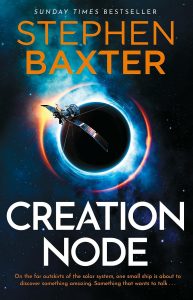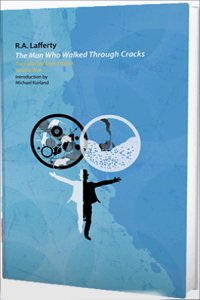Russell Letson Reviews Creation Node by Stephen Baxter
 Creation Node, Stephen Baxter (Gollancz 978-1 473-22895-5, £25.00, 442pp, hc) September 2023.
Creation Node, Stephen Baxter (Gollancz 978-1 473-22895-5, £25.00, 442pp, hc) September 2023.
Stephen Baxter’s Creation Node is a sprawling, multiviewpoint, multithreaded story that eventually knits together its strands and lights out for the cosmic territories, along the way touching on an encyclopedic range of classic science-fictional tropes and influences. Its generating event is the discovery of a mysterious body at the farthest fringes of the Oort Cloud, four light days out from the sun. The precise nature of the object unfolds gradually: What had been called Planet Nine at first appears to be a black hole, but it turns out to be something much stranger, a smooth, world-size artifact with miraculous physical properties and a number of surprises, including a single exemplar of an alien creature and an accompanying intelligence (from ‘‘far away across the quantum-froth multiverse’’) that has an enigmatic message for humankind.
Not that humankind is united enough to understand or respond very effectively to any such message. By 2255, Earthbound civilization has barely survived a series of climatic, ecological, and sociopolitical crises, and while we have gotten into space and made a solid start on settling and exploiting the moon and the asteroids, there is no agreement on whether – let alone how – to proceed with exploiting the solar system’s resources.
The cast of characters is distributed across three crucial factions. The Conservers, whose exploratory vessel Shadow encounters Planet Nine, are almost religiously dedicated to an ultrasustainable, long-horizon, zero-impact relationship with not only the Earth but the whole solar system, to the point where the use of any resource is examined for depletability. The miners and industrialists of the Lunar Consortium are their polar opposite, enthusiastically looking forward to exploiting the resources of the entire solar system on the way to building an expansive civilization that would last ‘‘tens of thousands of years.’’ But both are constrained by the political-economic establishment on Earth, where the planet’s slow recovery from a century of climatic disasters and social chaos depends on the fusion-powering helium-3 the Consortium mines on the moon.
This kind of future-political environment is familiar from a long line of writers from Heinlein and Alfred Bester to James S. A. Corey and Ian McDonald, while its larger story universe is descended from classic cosmology epics and speculations, from Stapledon to Fred Hoyle and Arthur C. Clarke – and Baxter himself. The factional maneuvering – political and material – in the foreground sometimes plays oddly against the enormous background issues raised by the existence of Planet Nine and the utterances and actions of the entity that comes to be called Terminus – and eventually by forces mysteriously associated with their manifestations.
The first person to see Planet Nine directly, and the one who notices that it is not behaving like a genuine primordial black hole, is Salma, the youngest – in fact, ship-born – member of the crew of the Shadow. The crew’s actions lead to a kind of 2001 moment as the object responds and is revealed to be something improbable. And then the impossibilities pile up: the clearly artificial nature of Planet Nine; the appearance of a single birdlike humanoid alien (named, inevitably, Feathers) whose behavior and physiology imply all manner of evolutionary mysteries; and the sudden manifestation of quasar radiation from the galaxy’s center, which threatens all human life in the solar system.
In the face of these events, some people take decent, rational actions. Salma and her crewmates, led by the careful and prudent captain Hild Kanigel, proceed cautiously, chewing over explanations and scenarios (sometimes at lengths that will have experienced SF readers chafing impatiently to get on with it) before taking any action. But back in the settled parts of the solar system, there are contending factions and individuals for whom cosmic mystery is less important than personal resentments, ambitions, or ideological programs and dreams: Doria Bohm, an intense and headstrong Consortium activist; John Smith, a cagey and persistent Conserver lawyer; Jeorg North, an aging space pilot looking for a last grand expedition; and the rather normative Elizabeth Vasta, science advisor to Earth’s President.
Some of these people do stupid, reckless, or destructive things for less-than-noble reasons, and others advance their faction’s programs and hopes, and their actions supply much of the plot machinery that dominates the middle of the book, as they jostle for advantage or for influence over the investigation of Planet Nine’s secrets. That side of Creation Node feels less like a Stapledonian cosmology epic than a future-world version of a prime-time domestic/political melodrama.
Nevertheless, the novel’s proper center of gravity is the effort of the crew of Shadow and some later participants to figure out what is in front of them: an anomalous, not-natural world; an alien being; the vatic pronouncements of Terminus; and finally a radically realigned vision of life in the universe. Much of that action takes the form of conversations and meetings and observations and speculations.
Which brings me to a third stream that runs through the book, one that I navigated with mixed feelings. While the story is filled with enigmatic, near-magical objects and effects, the basic scientific and technological elements are carefully accounted for and often outlined in action-stopping explanatory passages: staff meetings, chalk talks, and straight-up authorial backgrounders presented as matters a character knows.
For example, ‘‘Salma knew the theory’’ that ‘‘the Solar System in large was a thing of layers, like an onion, if a flattened onion. You had the Sun at the centre of it all, with the eight major planets in roughly the same orbital plane….’’ The rest of the passage runs for another page and a half explaining solar-system layout and gravitational perturbation. Elsewhere the reader is reminded about the nature of black holes, the persistence of mass in zero-gee environments, and other matters. (I wonder how much of the more advanced or exotic information could have been delivered in an appendix, say, next to the Afterword that supplies the extensive list of scientific and speculative sources and inspirations that were mined for the book’s ideas.)
Yet neither the chalk talks nor the political drama (which does finally drive a part of the resolution) prevented me from reading right through to the end. The cosmological speculations and their philosophical implications are strong stuff, and the way the characters navigate the mysteries drew me in. And the fates of Vasta, Salma, Feathers, and Hild mattered emotionally and thematically and hit me harder than the mind-bending cosmological machinery that brought them to the ends of their trajectories.
Russell Letson, Contributing Editor, is a not-quite-retired freelance writer living in St. Cloud MN. He has been loitering around the SF world since childhood and been writing about it since his long-ago grad school days. In between, he published a good bit of business-technology and music journalism. He is still working on a book about Hawaiian slack key guitar.
This review and more like it in the December and January 2023 issue of Locus.
 While you are here, please take a moment to support Locus with a one-time or recurring donation. We rely on reader donations to keep the magazine and site going, and would like to keep the site paywall free, but WE NEED YOUR FINANCIAL SUPPORT to continue quality coverage of the science fiction and fantasy field.
While you are here, please take a moment to support Locus with a one-time or recurring donation. We rely on reader donations to keep the magazine and site going, and would like to keep the site paywall free, but WE NEED YOUR FINANCIAL SUPPORT to continue quality coverage of the science fiction and fantasy field.
©Locus Magazine. Copyrighted material may not be republished without permission of LSFF.






